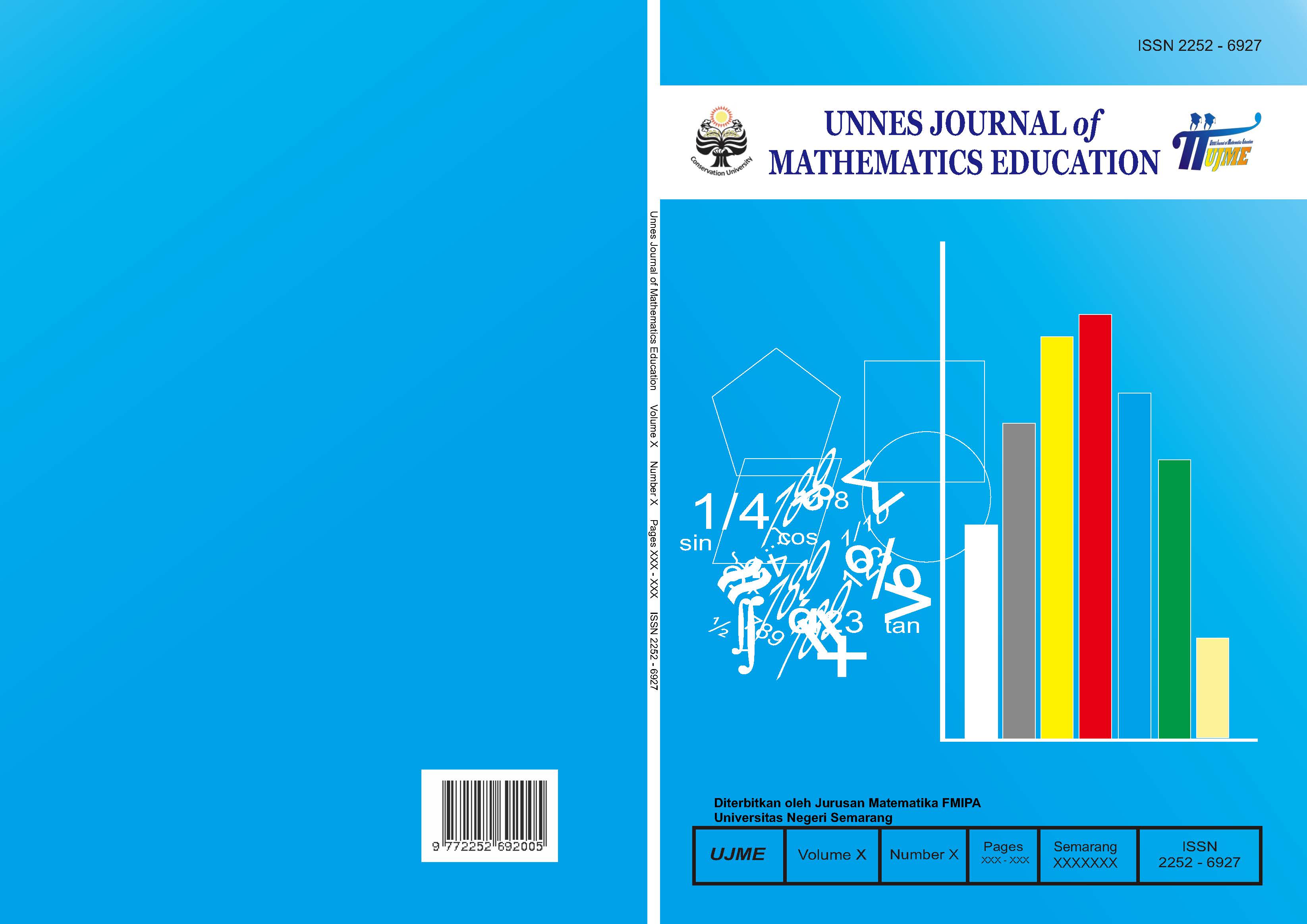ANALISIS KEMAMPUAN PEMECAHAN MASALAH DALAM PEMBELAJARAN MODEL AUDITORY INTELLECTUALY REPETITION
##plugins.themes.academic_pro.article.main##
Abstract
Abstrak
Penelitian ini bertujuan untuk mengetahui pencapaian ketuntasan klasikal kemampuan pemecahan masalah siswa kelas X SMA dengan menggunakan model pembelajaran Auditory Intellectually Repetition dan untuk mendeskripsikan kemampuan pemecahan masalah siswa kelas X SMA berdasarkan kelompok atas, sedang, dan bawah dalam pembelajaran Auditory Intellectually Repetition. Jenis penelitian ini adalah mixed methods. Metode pengumpulan data yang digunakan adalah dokumentasi, tes dan wawancara. Subjek penelitian ini adalah siswa kelas X-6 SMA Negeri 9 Semarang. Dipilih 6 siswa untuk dilakukan wawancara kemampuan pemecahan masalah yang terdiri dari 2 siswa pada masing-masing kelompok. Hasil penelitian menunjukkan bahwa: 1) kemampuan pemecahan masalah siswa dengan pembelajaran Auditory Intellectually Repetition mencapai ketuntasan klasikal 2) siswa kelompok atas mampu memahami masalah, mampu merencanakan penyelesaian, mampu melaksanakan rencana penyelesaian dan mampu melihat kembali hasil serta proses 3) siswa kelompok sedang hanya kurang mampu memahami masalah 4) siswa kelompok bawah kurang mampu memahami masalah dan kurang mampu melihat kembali hasil dan proses.
Abstract
The aim of the research is to determine the achievement of the classical completeness problem solving ability class X in Senior High School using Auditory Intellectually Repetition learning model and to describe the problem-solving skills class X in Senior High School based on the higher student group, the middle student groups and the lower student group in the learning Auditory Intellectually Repetition. This type of research is a mixed method. Data collection methods used were documentation, testing, and interviews.The subjects were students of class X-6 Senior High School 9 Semarang. The sixs selected students do the interviews troubleshooting capabilities consisting of two students in each group. The results showed that: 1) the problem solving ability of students with learning Auditory Intellectually Repetition reach the classical completeness 2) the higher student group able to understand the problem, able to plan completion, able to carry out the settlement plan and were able to look over the results and process 3) the middle student groups are less capable of understanding the problem 4) and the lower student groups are less able to understand the problems and less able to look back results and processes.
##plugins.themes.academic_pro.article.details##
References
BSNP. 2006. Standar Kompetensi dan Kompetensi Dasar SMP/MTs.Jakarta:BSNP.
Depdiknas. 2007. Kajian Kebijakan Kurikulum Mata Pelajaran Matematika. Jakarta: Departemen Pendidikan Nasional.
Effendi, L. A. 2012. Pembelajaran Matematika dengan Metode Penemuan Terbimbing untuk Meningkatkan Kemampuan Representasi dan Pemecahan Masalah Matematis Siswa SMP. Jurnal Penelitian Pendidikan Universitas Pendidikan Indonesia, 13 (2) , 1-10.
Laksana, R.A.T, Rochmad & M. Kharis. 2014. Keefektifan Model Pembelajaran STAD disertai Permainan MAM terhadap Kemampuan Pemecahan Masalah Kelas X Materi Logaritma. Unnes Journal of Mathematics Education. 3(2): 125-131.
Latifah, N.U, A. Agoestanto, 2014. Keefektifan Model Pembelajaran AIR dengan Pendekatan RME terhadap Kemampuan Komunikasi Matematik Materi Geometri Kelas VII. Unnes Journal of Mathematics Education. 4(1):15-21
Marliani. 2015. Kemampuan Pemecahan Masalah Matematis. Jurnal Formatif 5(2): 134-144. Tersedia di http://journal.lppmunindra.ac.id/ index.php/ Formatif/ article/viewFile/333/316 [diakses 8-1-2016].
Meier, D. 2002. The Accelerated Learning Handbook: Panduan Kreatif & Efektif Merancang Program Pendidikan dan Pelatihan: Penerjemah, Rahmani Astuti. Bandung: Kaifa.
NCTM. 2000. Principles and Standars for School Mathematics. Tersedia di http://www.nctm.org/. [diakses 16-11-2015].
OECD. 2010. PISA 2009 results: What Students Know and Can Do–Student Perfomance in Reading, Mathematics, and Science (Volume I). Tersedia di http//dx.doi.org/10.1787/9789264091450-en [diakses pada tanggal 6 Desember 2015].
Polya, G. 1973. How to Solve It. New Jersey: Princeton University Press.
Sugiyono, 2013. Metode Penelitian Pendidikan Pendekatan Kuantitatif Kualitatif dan R&D. Bandung: Alfabeta.
